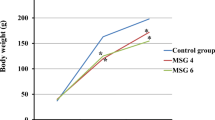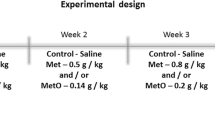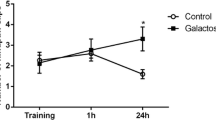Abstract
In the present study, we developed an acute chemically induced model of sarcosinemia in Wistar rats. Wistar rats of 7, 14 and 21 postpartum days received sarcosine intraperitoneally in doses of 0.5 mmol/Kg of body weight three time a day at intervals of 3 h. Control animals received saline solution (NaCl 0.85 g%) in the same volume (10 mL/Kg of body weight). The animals were killed after 30 min, 1, 2, 3 or 6 h after the last injection and the brain and the blood were collected for sarcosine measurement. The results showed that plasma and brain sarcosine concentrations achieved levels three to four times higher than the normal levels and decreased in a time-dependent way, achieving normal levels after 6 hours. Considering that experimental animal models are useful to investigate the pathophysiology of human disorders, our model of sarcosinemia may be useful for the research of the mechanisms of neurological dysfunction caused by high tissue sarcosine levels.



Similar content being viewed by others
References
Bar-Joseph I, Pras E, Reznik-Wolf H, et al. (2012) Mutations in the sarcosine dehydrogenase gene in patients with sarcosinemia. Hum Genet 131:1805–1810
Bayer SA, Altman J (1995) Principles of neurogenesis, neuronal migration, and neural circuit formation. In: Paxinos G (ed) The rat nervous system, 3rd edn. Academic Press, San Diego, pp. 1079–1098
Bayer SA, Altman J, Russo RJ, Zhang X (1993) Timetables of neurogenesis in the human brain based on experimentally determined patterns in the rat. Neurotoxicology 14:83–144
Bergeron F, Otto A, Blache P, Day R, Denoroy L, Brandsch R, Bataille D (1998) Molecular cloning and tissue distribution of rat sarcosine dehydrogenase. Eur J Biochem 257:556–561
Bridi R, Fontella FU, Pulrolnik V, Braun CA, Zorzi GK, Coelho D, Wajner M, Vargas CR, Dutra-Filho CS (2006) A chemically-induced acute model of maple syrup urine disease in rats for neurochemical studies. J Neurosci Meth 155:224–230
Brusque AM, Mello CF, Buchanan DN, Terraciano ST, Rocha MP, Vargas CR (1999) Effect of chemically induced propionic acidemia on neurobehavioural development of rats. Pharmacol Biochem Behav 64:529–534
Cicero TJ, Adams ML, Giordano A, Miller BT, O’Connor L, Nock B (1990) Influence of morphine exposure during adolescence on the sexual maturation of male rats and the development of their offspring. J Pharmacol Exp Ther 256:1086–1093
Clark JB, Bates TE, Cullingford T, Land JM (1993) Development of enzymes of energy metabolism in the neonatal mammalian brain. Dev Neurosci 15:174–180
Deutsch SI, Rosse RB, Long KD, Gaskins B, Mastropaolo J (2006) Rare neurodevelopmental abnormalities of sarcosinemia may involve glycinergic stimulation of a primed N-methyl-d-aspartate receptor. Clin Neuropharmacol 29:361–363
Dutra JC, Wajner M, Wannmacher CMD, Wannmacher LE, Pires RF, Rosa-Junior A (1991) Effect of postnatal methylmalonate administration on adult rat behavior. Braz J Med Biol Res 24:595–605
Enesco M, Leblond CP (1962) Increase in cell number as a factor in the growth of the organs and tissues of the young male rat. J Embryol Exp Morphol 10:530–562
Gemelli T, de Andrade RB, Rojas DB, Bonorino NF, Mazzola PN, Tortorelli LS, Funchal C, Dutra-Filho CS, Wannmacher CMD (2013) Effects of b-alanine administration on selected parameters of oxidative stress and phosphoryltransfer network in cerebral cortex and cerebellum of rats. Mol Cell Biochem 80:161–170. doi:10.1007/s11010-013-1669-8
Gerritsen T, Waisman HA (1966) Hypersarcosinemia: an inborn error of metabolism. N Engl J Med 275:66–69
Harding CO, Williams P, Pflanzer DM, Colwell RE, Lyne PW, Wolff JA (1992) SAR: a genetic mouse model for human sarcosinemia generated by ethylnitrosourea mutagenesis. Proc Nat Acad Sci. 89: 2644–2648
Herdon HJ, Godfrey FM, Brown AM, Coulton S, Evans JR, Cairns WJ (2001) Pharmacological assessment of the role of the glycine transporter GlyT-1 in mediating high-affinity glycine uptake by rat cerebral cortex and cerebellum synaptosomes. Neuropharmacology 41:88–96
Himwich WA (1973) Problems in interpreting neurochemical changes occurring in developing and aging animals. In: Ford DH (ed) Neurobiological effects of maturation and aging. Progress in Brain Research, Elsevier Scientific, Amsterdam, pp. 13–23
Jacobson M (1978) Histogenesis and morphogenesis of the central nervous system. In: Jacobson M (ed) Developmental neurobiology. Plenum Press, New York, pp. 57–114
Jiang Y, Cheng X, Wang C, Ma Y (2010) Quantitative determination of sarcosine and related compounds in urinary samples by liquid chromatography with tandem mass spectrometry. Anal Chem 82:9022–9027. doi:10.1021/ac1019914
Kimmel CA (1998) Current approaches. In: Slikker WJr, Chang LW (ed) Developmental neurotoxicology, Academic Press, San Diego, pp 675–685
Kracht LW, Friese M, Herholz K, Schroeder R, Bauer B, Jacobs A, Heiss WD (2003) Methyl-[11C]- l-methionine uptake as measured by positron emission tomography correlates to microvessel density in patients with glioma. Eur J Nucl Med Mol Imaging 30:868–873
Krinke G, Eisenbrandt DL (1994) In: Mohr U, Dungworth DL, Capen CC (eds) Pathobiology of the aging rat. ILSI Press, Washington DC, pp. 3–9
Lopez-Corcuera B, Martinez-Maza R, Nunez E, Roux M, Supplisson S, Aragon C (1998) Differential properties of two stably expressed brain-specific glycine transporters. J Neurochem 71:2211–2219
Mallorga PJ, Williams JB, Jacobson M, Marques R, Chaudhary A, Conn PJ, Pettibone DJ, Sur C (2003) Pharmacology and expression analysis of glycine transporter GlyT1 with [3 H]-(N-[3-(4′-fluorophenyl)-3-(4′phenylphenoxy)propyl])sarcosine. Neuropharmacology 45:585–593
Marzo A (1997) Clinical pharmacokinetic registration file for NDA and ANDA procedures. Pharmacol Res 36:425–450
Moreira JC, Wannmacher CMD, Costa SM, Wajner M (1989) Effect of proline administration on rat behavior in aversive and nonaversive tasks. Pharmacol Biochem Behav 32:885–890
O’Kane RL, Hawkins RA (2003) Na + −dependent transport of large neutral amino acids occurs at the abluminal membrane of the blood-brain barrier. Am J Physiol Endocrinol Metab 285:1167–1173
Ross EM, Gilman AG (1990) Pharmacodynamics: mechanism of drug action and the relationship between drug concentration and effect. In: Gilman AG, Goodman LS, Rall TW, Murad F (eds) The pharmacological basis of therapeutics, 8rd edn. Macmillan Publishing Company, New York chapter 2
Schardein JL (1998) Animal/human concordance in: slikker WJr, Chang LW (ed) handbook of developmental neurotoxicology. Academic Press, San Diego, pp. 687–708
Schulze C, Firth JA (1992) Interendothelial junctions during blood-brain barrier development in the rat: morphological changes at the level of individual tight junctional contacts. Dev Brain Res 69:85–95
Scott CR (2001) Sarcosinemia. In: Scriver CR, Beaudet AL, Sly WS, Valle D (eds) The metabolic and molecular bases of inherited disease. The McGraw-Hill Companies, New York, pp. 2057–2063
Sgaravatti AM, Vargas BA, Zandoná BR, Deckmann KB, Rockenbach FJ, Moraes TB, Monserrat JM, Sgarbi MB, Pederzolli CD, Wyse AT, Wannmacher CM, Wajner M, Dutra-Filho CS (2008) Tyrosine promotes oxidative stress in cerebral cortex of young rats. Int J Dev Neurosci 26:551–559
Skvorak KJ (2009) Animal models of maple syrup urine disease. J Inherit Metab Dis 32:229–246
Smith KE, Borden LA, Hartig PR, Branchek T, Weinshank RL (1992) Cloning and expression of a glycine transporter reveal colocalization with NMDA receptors. Neuron 8:927–935
Socala K, Nieoczym D, Rundfeldt C, Wlaz (2010) Effects of sarcosine, a glycine transporter type 1 inhibitor, in two mouse seizure models. Pharmacol Rep 62: 392–397
Stefanello FM, Matté C, Scherer EB, Wannmacher CMD, Wajner M, Wyse ATS (2007) Chemically induced model of hypermethioninemia in rats. J Neurosci Methods 160:1–4
Streck EL, Matté C, Vieira PS, Rombaldi F, Wannmacher CMD, Wajner M (2002) Reduction of Na+,K + −ATPase activity in hippocampus of rats subjected to chemically induced hyperhomocysteinemia. Neurochem Res 27:1593–1598
Ueland PM, Midttun O, Windelberg A, Svardal A, Skalevik R, Hustad S (2007) Quantitative profiling of folate and one-carbon metabolism in large-scale epidemiological studies by mass spectrometry. Clin Chem Lab Med 45:1737–1745
Winick M, Noble A (1965) Quantitative changes in DNA, RNA and protein during prenatal and postnatal growth in rat. Dev Biol 12:451–466
Wyse ATS, Sarkis JJF, Cunha-Filho JS, Teixeira MV, Schetinger MR, Wajner M (1995) ATP diphosphohydrolase activity in synaptosomes from cerebral cortex of rats subjected to chemically induced phenylketonuria. Braz J Med Biol Res 28:643–649
Wyse ATS, Sarkis JJF, Cunha-Filho JS, Teixeira MV, Schetinger MR, Wajner M, et al. (1994) Effect of phenylalanine and its metabolites on ATP diphosphohydrolase activity in synaptosomes from rat cerebral cortex. Neurochem Res 19:1175–1180
Zhang HX, Hyrc K, Thio LL (2009) The glycine transport inhibitor sarcosine is an NMDA receptor co-agonist that differs from glycine. J Physiol 587:3207–3220
Acknowledgments
This work was supported by the research grants from Programa de Núcleos de Excelência (PRONEX), Coordenação de Aperfeiçoamento de Pessoal de Nível Superior (CAPES), Conselho Nacional de Desenvolvimento Científico e Tecnológico (CNPq), Fundação de Amparo à Pesquisa do Estado do Rio Grande do Sul (FAPERGS) and FINEP Rede Instituto Brasileiro de Neurociência.
Author information
Authors and Affiliations
Corresponding author
Rights and permissions
About this article
Cite this article
de Andrade, R.B., Gemelli, T., Rojas, D.B. et al. Chemically induced acute model of sarcosinemia in wistar rats. Metab Brain Dis 31, 363–368 (2016). https://doi.org/10.1007/s11011-015-9759-9
Received:
Accepted:
Published:
Issue Date:
DOI: https://doi.org/10.1007/s11011-015-9759-9




